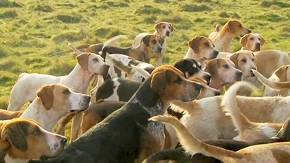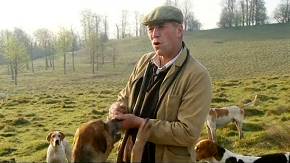
|
The world of non-commercial film and A-V |
Events Diary | Search | ||
| The Film and Video Institute | | ||||
To BIAFF 2011 results | To Full Making Of Index
Documentary Film Making
and
Audience Prejudice
Michael Slowe on his film Hounds & The Huntsman
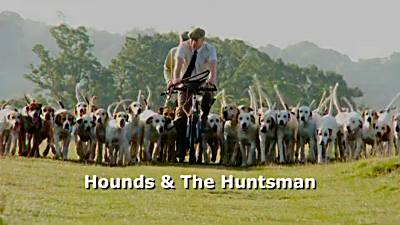 |
Should a documentary film maker be influenced by the possibility that
some people viewing the film might be offended by either the subject or the
manner in which it is presented?
I ask this question since my latest documentary has already provoked negative reaction from some even before they have seen the film! Perhaps I erred in choosing my title Hounds & The Huntsman. This has elicited the comment "I hope you're not supporting fox hunting." Well, no I'm not, for two reasons. Firstly the film is not about fox hunting at all as this is in fact currently illegal. Secondly I never take a stance in my documentaries (some criticise me for this) since I merely observe and present the action for the viewer to make what he wants from what he sees. |
| As in an earlier film, I observe a man developing a special
relationship with the animals he works with. The fact that they are a pack
of foxhounds which, before the law was changed some six years ago, used to
hunt foxes, was not my concern. I generally try and make documentaries that
feature either an unusual character or an unusual occupation, preferably
both at once as in this case. I take no position as to the morality of what
they do, provided it's legal.
So, with all this in mind, I want to describe some of the details concerning the making of the film and some of the problems I met, mostly ever present in documentary filmmaking. |
|
| The main difficulty is that however the subject might be researched (and there was none for this project) one never knows in advance what there will be to shoot and in quite what circumstances. This was obviously going to be mostly an outdoor shoot which meant that variables such as weather and light were going to be very important. I also had to be prepared to be fast on my feet both in physical movement and technically in adjusting a sophisticated camera to cope with rapid changes in shot requirement. Any wedding videographer will be familiar with this concept although I have to say that a wedding is generally planned to a formula and therefore can be predicted to some extent. | 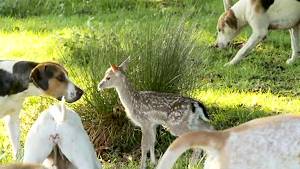 |
| Mobility was important for me and virtually the whole shoot would be hand held and the shoulder support I used on my last film was once again a lifesaver. (CVP Shoulder Brace from www.mitcorp.com) Without it I could never have held the Sony EX 1 steady enough for hours on end and, at the same time, leaving my left hand free for focus and iris adjustments. I had to have available options for recording audio, combining an on-camera microphone with a stand-alone directional Sennheiser if there was someone to hold it or the Sennheiser radio mic. which was invaluable in capturing speech when the subject was some distance away and there was a lot of ambient sound. |
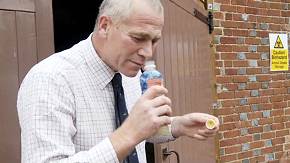 |
|
|
Adrian (Sage) Thompson - the huntsmanMy subject then, was a huntsman and his hounds, as the title indicates, and therefore the kennels was to be my starting point. |
|
| The man himself - Adrian Thompson, usually known as Sage - is a real 'character' and once I had established a rapport with him and explained what I was aiming for we were up and running. I was immediately relieved to find that he was a natural performer and quite comfortable on camera. The hounds were a different proposition as they also want to perform by jumping all over me at every opportunity making it extremely difficult to hold the camera steady. They also persist in putting their noses into very personal areas, a further obstacle to obtaining steady pictures. A pack of foxhounds has a very distinctive smell which is quite difficult to remove from clothing and the family dog asked awkward questions when ever I returned from a shoot. | 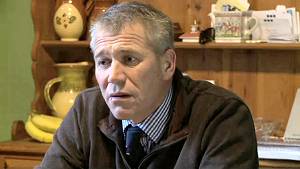 |
Early on in making this type of film I like to get the main
character on camera, in a controlled situation, just talking. This is how
I obtain my 'script' for my film. I encourage him to talk about everything
connected with his job and his life. I'm not concerned with fluffs and
hesitations as I'll only be using a fraction of the material. Most of the
talking will be laid over other action and I can edit out any pauses or coughs.
I did this in Sage's kitchen in the house he occupies adjacent to the kennels
in Petworth Park. Here at least I could control the lighting and audio although
my key light was daylight from a window so I had to be wary of level changes.
I much prefer this method of obtaining my narration rather than getting someone
to read something specially written. I give my subject some guidance in what
I want but generally prefer to wait and see what comes out. If I find a serious
information gap I can record more later on. This way the words have a spontaneity
that would not otherwise be the case. It is important to have the initial
contact to camera so the audience understands whose voice they are hearing
but I have to avoid the impression that the film is a 'talking head' so keep
the pieces-to-camera to a minimum.
Filming in the field |
|
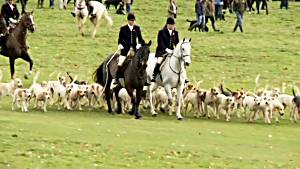 |
Out in the field it was a different matter as I had no control of events, neither action nor speech. In order to record good audio I often fitted a radio mic. to the character and ensured that I kept within range of the signal. There is always the risk of interference and crackles particularly if the subject is moving and bending when either the mic. itself or the transmitter is knocked. I was very fortunate that my subject kept talking good sense and was making a useful contribution to the audio content. This gave me even more options but I didn't use all the live audio, on occasions I selected what I considered more relevant material from the recording to camera, and laid this over the pictures. |
| I never set the audio recording to manual in these circumstances as, with all the other aspects to take care of, monitoring and adjusting recording levels simply is not possible. The only way this can be done is by having a sound man recording to his separate equipment. The professionals do this and merely record the audio in camera for guide purposes to assist the editor. With this film I did have someone (a granddaughter actually), holding a directional M6 microphone for some of the show sequences in order to obtain better audio. This can be more trouble than it's worth because the boom holder has to know how to keep out of shot and there is the connecting cable adding more complications. Here again, the professionals manage since the sound crew are experienced and know the score. | |
| The camerawork is fairly straightforward for me now I'm familiar with the EX 1. As I mentioned the shoulder support was invaluable as was the facility with this camera for switching to auto focus in an instant by clicking the focus barrel towards me. I prefer to manually focus mostly but there are times when rapid movement of the subject (in this case hounds) means that an efficient 'follow focus' facility is helpful. The EX is first rate in this regard. The small screens on these modern cameras can make focusing difficult, especially in bright light, and, although I have a good hood over the screen this does not entirely solve the problem. Oh for a proper high resolution electronic viewfinder! Unfortunately, in these HD days the finder would cost as much as the camera! | 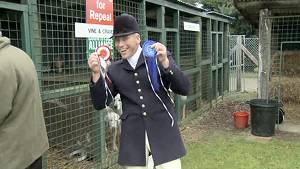 |
The huntsman exercises his pack at six o'clock in the morning
which meant some early starts for me. In order to plan for reasonable weather
I attempted to obtain really accurate local weather forecasts and I must
say the Met Office came up trumps. Very often I was transported around on
a quad bike so as to be able to anticipate action. By definition reportage
documentaries have to be impromptu and not staged but it did help to be able
to be in the right place on occasions. Staying on the extremely unstable
machine, clutching a mud spattered camera and trying to prevent the folded
tripod from falling off the back required all my (failing) strength. It was
worth it just to get the opening shot. This has been much appreciated by
all who see the film and did mean I had to be in position, camera on a tripod,
focus in auto because the whole pack were approaching and there was no way
I could risk a manual focus pull. This was to be the title shot and there
is nothing worse than having titles jiggling around a jerky picture. It isn't
of course the letters that are moving but the background but the effect is
the same.
The Edit |
|
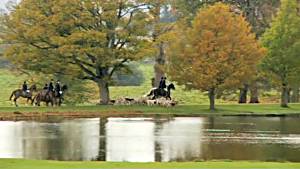 |
The edit presented me with the usual dilemma of how to structure the film and as I relate below I may not have succeeded. As I wrote at the start, I'm not conveying any specific message, just hoping to present in documentary fashion, the country scene of a man enjoying and taking pride in his job. The fact that he is a charismatic figure, much respected and admired by his local community is incidental, although a vital ingredient as far as I, the filmmaker, was concerned. I also appreciated that the action was, for the most part, taking place in photogenic surroundings. The latter is important to me as I like my films to give pleasure visually whenever possible. The fact that the judges for this year's BIAFF have awarded the film Best Photography justifies this aim I think. |
| I had about thirty five hours of HD footage to work with and was hoping to limit the length of the finished production to thirty minutes. For those interested in such matters I imported the media into my edit system in the Apple ProRes HQ 422 codec. This maintains the specification and picture quality of HD but, by some miraculous engineering, occupies dramatically less drive space than some other HD codecs. I edit with the Media 100 software on a MacPro computer. | |
| I often produce a number of 'rough cuts' during the edit in order to view the film on a big screen and to test my audio balance on equipment other than my studio speaker monitors. I also let one or two people whose judgement I trust, comment on the film. Notably an ex advertising executive with experience of making decisions on very expensive TV commercials where every frame counts. The final judges for BIAFF made the relevant comment that they didn't think that I got the structure right bearing in mind the material that I had at my disposal. The suggestion was that a documentary has to tell a story, rather than consist of individual episodes as this does, and that the narrative has to build up to "some sort of climax or conclusion". They may have something there I have to admit. The problem is that life does not consist of logical narrative and very often there is no conclusion, save for the obvious final one! | 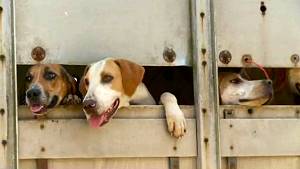 |
| My initial 'final cut' runs for forty three minutes but I've also produced a thirty eight minute version for film festivals such as BIAFF. Curiously though, the minor Sky TV channel (Horse & Country TV) that has broadcast two previous productions of mine in the last few months, wanted a version running forty eight minutes. They viewed the others and asked if I had enough material to give them more so I obliged. I hasten to add here that all my filmmaking is on a strictly 'non commercial' basis and any fees resulting go to charity and that I never respond to requests to produce a film other than one that I really want to make for my own satisfaction. | |
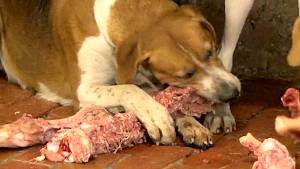 |
Now that I have access to some very good encoding software I produce DVD's for the exhibition of my films. I used to abhor the quality that the compressed MPEG 2 codec produced on the screen but I'm now delighted that the image on my DVD's certainly looks every bit as good as that produced by tape. Blu-Ray discs look even better of course and anyone filming in HD should aim to produce Blu-Ray's to preserve the HD quality of their pictures. I'm finding that increasing numbers of clubs and homes can handle Blu-Ray. The Panasonic Blu-Ray player costs £99 at John Lewis! This makes sense because virtually every TV sold in the last five years is able to display HD. |
| I hope that those visiting BIAFF will enjoy this film and I'm
told that it will be included in one of the Award Shows on Sunday. All I
ask is that audiences do not pre judge the theme or content, all is not always
as it seems.
Hounds & The Huntsman won a 5-Star award, Best Photography Award and Best Documentary Award at BIAFF 2011. |
|
Share your passions.

Share your stories.
